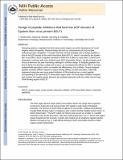Design of Peptide Inhibitors That Bind the bZIP Domain of Epstein–Barr Virus Protein BZLF1
Author(s)
Chen, T. Scott; Reinke, Aaron W.; Keating, Amy E.
DownloadKeating_Design of.pdf (2.349Mb)
PUBLISHER_CC
Publisher with Creative Commons License
Creative Commons Attribution
Terms of use
Metadata
Show full item recordAbstract
Designing proteins or peptides that bind native protein targets can aid the development of novel reagents and/or therapeutics. Rational design also tests our understanding of the principles underlying protein recognition. This article describes several strategies used to design peptides that bind to the basic region leucine zipper (bZIP) domain of the viral transcription factor BZLF1, which is encoded by the Epstein–Barr virus. BZLF1 regulates the transition of the Epstein–Barr virus from a latent state to a lytic state. It shares some properties in common with the more studied human bZIP transcription factors, but also includes novel structural elements that pose interesting challenges to inhibitor design. In designing peptides that bind to BZLF1 by forming a coiled-coil structure, we considered both affinity for BZLF1 and undesired self-association, which can weaken the effectiveness of an inhibitor. Several designed peptides exhibited different degrees of target-binding affinity and self-association. Rationally engineered molecules were more potent inhibitors of DNA binding than a control peptide corresponding to the native BZLF1 dimerization region itself. The most potent inhibitors included both positive and negative design elements and exploited interaction with the coiled-coil and basic DNA-binding regions of BZLF1.
Date issued
2011-02Department
Massachusetts Institute of Technology. Department of BiologyJournal
Journal of Molecular Biology
Publisher
Elsevier
Citation
Chen, T. Scott, Aaron W. Reinke, and Amy E. Keating. “Design of Peptide Inhibitors That Bind the bZIP Domain of Epstein–Barr Virus Protein BZLF1.” Journal of Molecular Biology 408, no. 2 (April 2011): 304–320.
Version: Author's final manuscript
ISSN
00222836
1089-8638